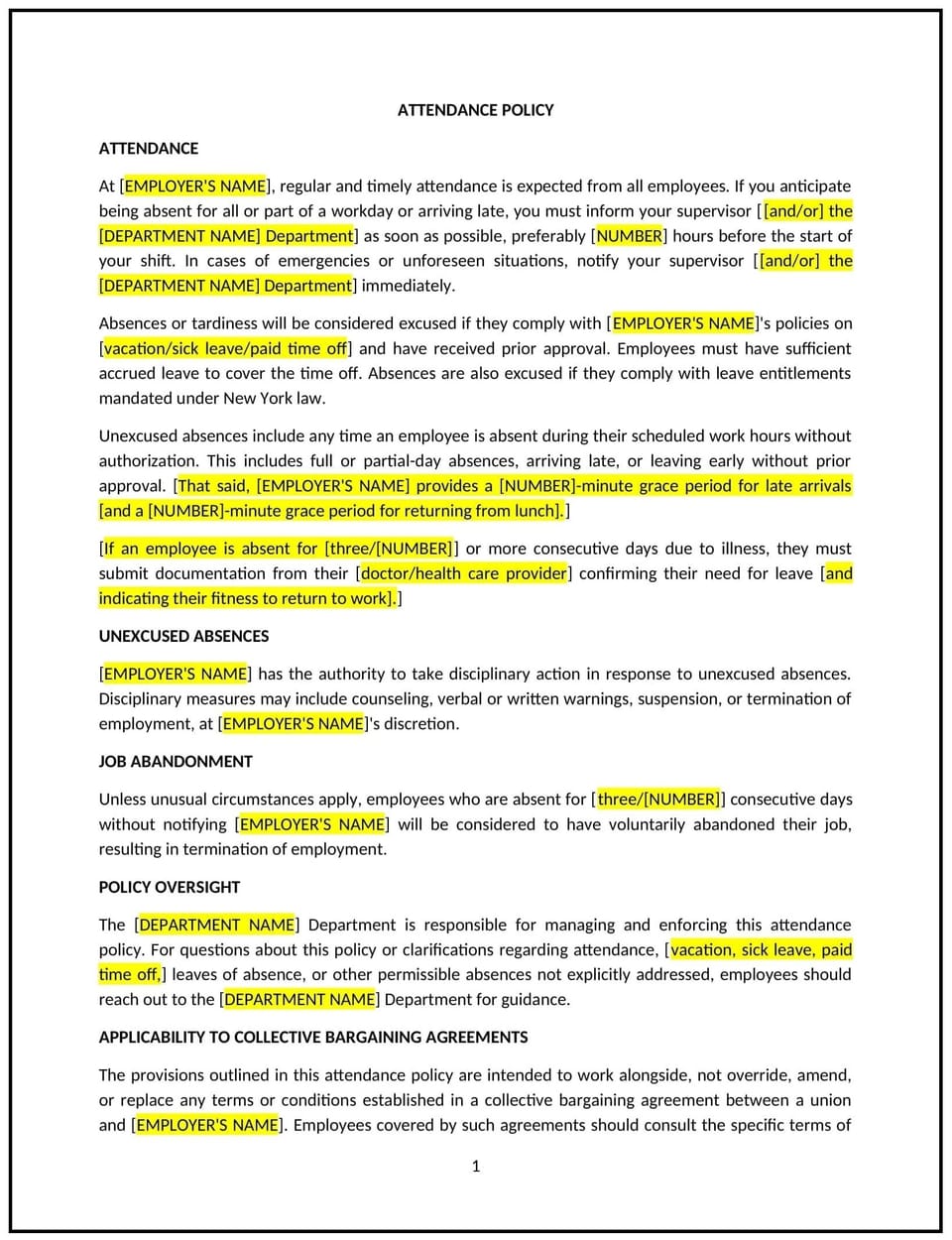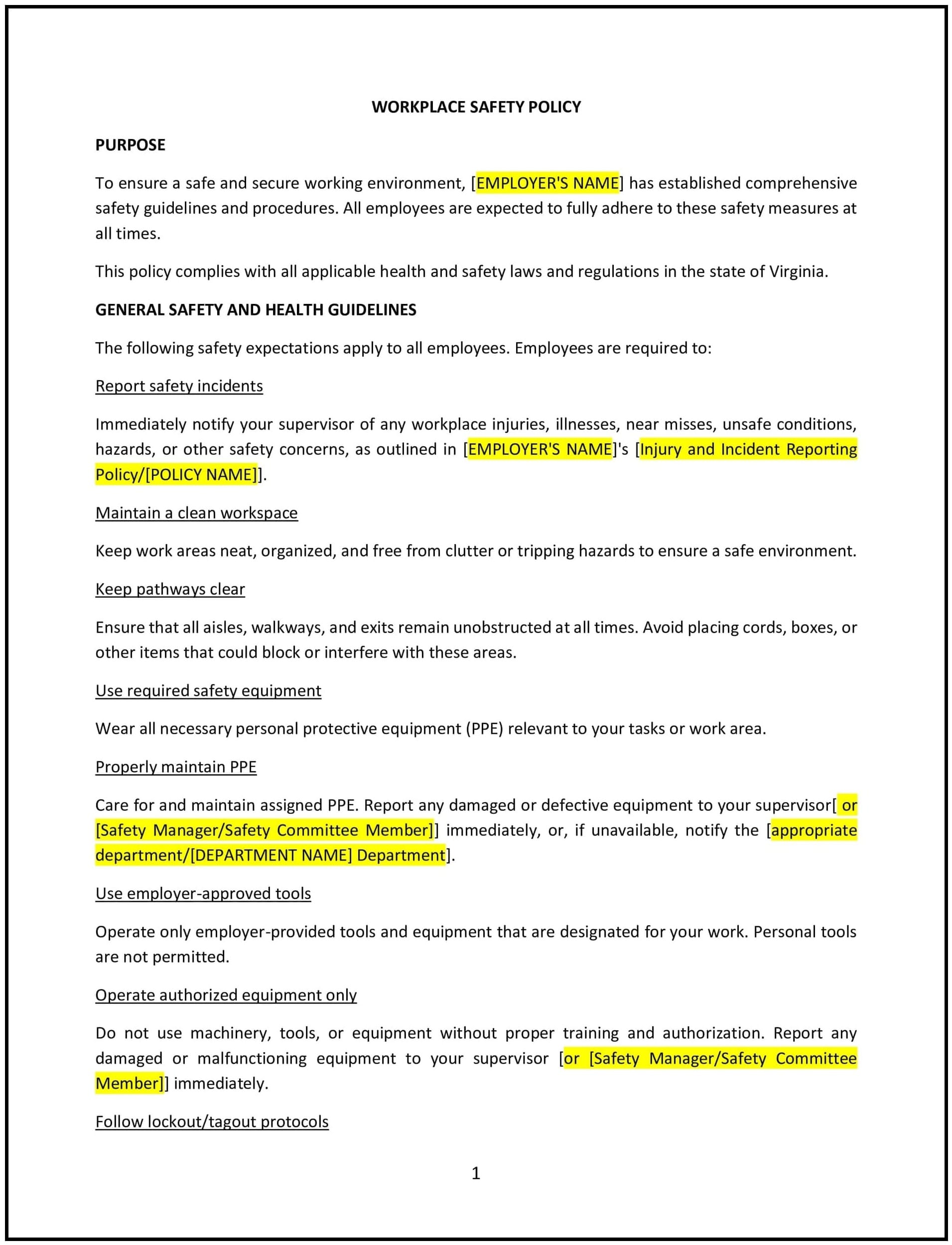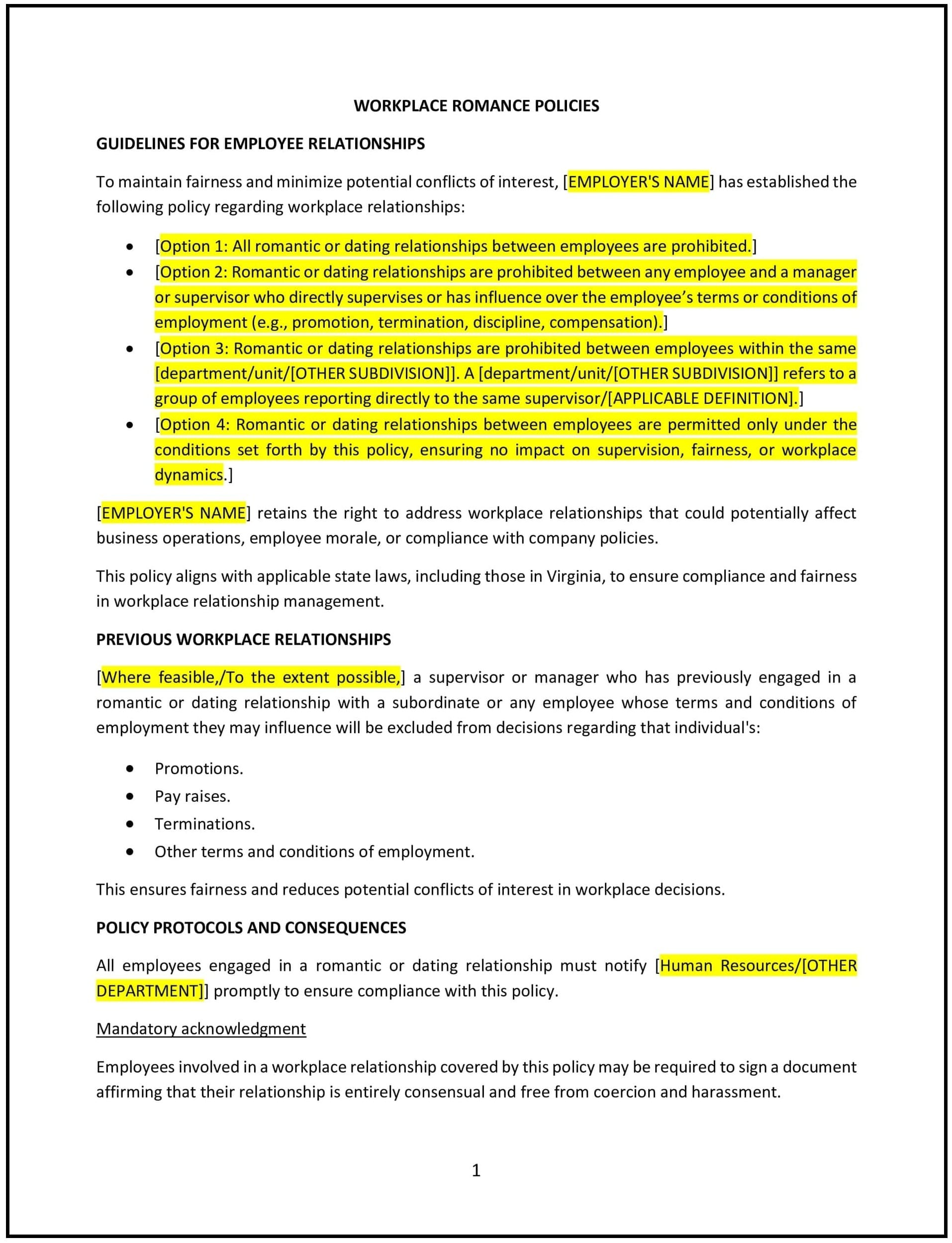Attendance policy (New York): Free template

Attendance policy (New York)
An attendance policy helps New York businesses establish clear expectations regarding employee attendance, punctuality, and absences. This policy outlines the procedures for requesting time off, reporting absences, and the consequences for non-compliance with attendance guidelines. It also includes provisions for handling different types of leave, including sick leave, vacation, personal days, and any legally mandated leave. The policy is designed to ensure that businesses can maintain productivity while being fair and consistent in its approach to managing employee attendance.
By implementing this policy, businesses can minimize disruptions caused by absenteeism, promote accountability among employees, and comply with New York state and federal leave laws.
How to use this attendance policy (New York)
- Define attendance expectations: Clearly outline the expectations for attendance and punctuality, including the start and end times of work shifts, the procedure for notifying managers of tardiness, and the requirement for employees to be present during scheduled work hours unless they have approved leave.
- Set guidelines for reporting absences: Establish clear procedures for employees to report absences, including the required notice period (e.g., 24 hours in advance), the method of reporting (e.g., phone call, email), and who to contact when unable to attend work.
- Address various types of leave: Specify the different types of leave available to employees, including sick leave, vacation, personal days, and any additional leave mandated by New York state or federal law, such as Family and Medical Leave Act (FMLA) leave.
- Outline the process for requesting time off: Provide employees with clear guidelines on how to request time off, including the approval process, how far in advance the request should be submitted, and any documentation that may be required for specific types of leave, such as medical certificates.
- Define consequences for non-compliance: Establish the consequences for employees who fail to adhere to the attendance policy, including progressive disciplinary actions such as verbal warnings, written warnings, suspension, or termination, depending on the severity of the absenteeism.
- Address excessive absenteeism: Define what constitutes excessive absenteeism and provide a process for managing employees with attendance issues, including offering support, discussing possible accommodations, and setting expectations for improvement.
- Comply with New York state and federal leave laws: Ensure that the policy complies with all relevant state and federal laws regarding leave entitlements, such as FMLA, paid sick leave, and other mandated leave policies in New York.
Benefits of using this attendance policy (New York)
This policy offers several benefits for New York businesses:
- Reduces absenteeism: By setting clear expectations and providing guidelines for requesting time off, the policy helps reduce unscheduled absenteeism and ensures that employees understand the importance of being present and punctual at work.
- Promotes accountability: The policy holds employees accountable for their attendance, encouraging responsibility and helping maintain smooth operations and productivity.
- Ensures fairness and consistency: The policy ensures that attendance issues are handled fairly and consistently across the business, reducing the risk of favoritism or discrimination. It provides a clear process for managing attendance-related issues and applying consequences for non-compliance.
- Enhances productivity: By minimizing absenteeism and encouraging employees to follow attendance guidelines, the policy helps maintain a productive work environment where tasks and responsibilities are consistently met.
- Supports legal compliance: The policy ensures that businesses comply with New York state and federal leave laws, including sick leave, family leave, and disability accommodations, reducing the risk of legal issues related to employee attendance and leave requests.
- Improves employee satisfaction: By being transparent about attendance expectations and leave policies, the policy helps employees understand their rights and responsibilities, reducing confusion and fostering a more positive work environment.
Tips for using this attendance policy (New York)
- Communicate the policy clearly: Ensure that all employees understand the attendance policy, including how to request time off, report absences, and adhere to attendance guidelines. This can be done through employee handbooks, onboarding materials, and regular reminders.
- Track attendance: Maintain accurate records of employee attendance to monitor patterns and identify any issues that may require attention. Tracking attendance helps businesses ensure that the policy is being followed and enables better planning for staffing needs.
- Be consistent in enforcement: Apply the policy consistently across the organization, ensuring that all employees are held to the same standards. This includes ensuring that disciplinary actions for non-compliance are fair and consistent.
- Provide support for employees with attendance issues: Address attendance issues early by offering support to employees who may be struggling, such as offering accommodations, discussing underlying issues, or providing resources for managing health or personal concerns.
- Review and update the policy regularly: Periodically review the policy to ensure it remains effective, compliant with changes in New York laws, and aligned with the business’s evolving needs. Regular updates help ensure the policy continues to meet its objectives.
Q: Why is an attendance policy important for businesses?
A: This policy is essential because it helps businesses ensure that employees are present and punctual, which is key to maintaining productivity and smooth operations. It also establishes clear guidelines for requesting time off and addresses absenteeism in a fair and consistent manner.
Q: What types of leave are covered under this policy?
A: The policy covers various types of leave, including sick leave, vacation, personal days, and any leave mandated by New York state or federal laws, such as FMLA. It ensures that employees understand their entitlements and the process for requesting time off.
Q: How do employees report an absence?
A: Employees should report absences as soon as possible by notifying their supervisor or HR through the designated method, such as a phone call or email. The policy specifies how far in advance the notice should be provided and who to contact when they are unable to attend work.
Q: What happens if an employee has excessive absenteeism?
A: The policy defines what constitutes excessive absenteeism and outlines the process for addressing it. This may include progressive disciplinary actions, offering support, or setting performance improvement expectations to address the underlying causes of absenteeism.
Q: How does a business handle time off requests?
A: Employees must submit time off requests through the designated process, ensuring that all requests are made with adequate notice. The policy provides clear guidelines on how far in advance requests should be submitted and what documentation, if any, is required for specific types of leave.
Q: What are the consequences of not following the attendance policy?
A: The policy specifies the consequences for not adhering to attendance guidelines, which may include progressive disciplinary actions such as verbal or written warnings, suspension, or termination, depending on the severity of the attendance issue.
Q: How often should this policy be reviewed?
A: The policy should be reviewed regularly, at least annually, to ensure that it remains effective and compliant with any changes in New York state laws or business needs. Regular reviews help ensure that the policy continues to serve its purpose and address any new challenges related to employee attendance.
This article contains general legal information and does not contain legal advice. Cobrief is not a law firm or a substitute for an attorney or law firm. The law is complex and changes often. For legal advice, please ask a lawyer.


